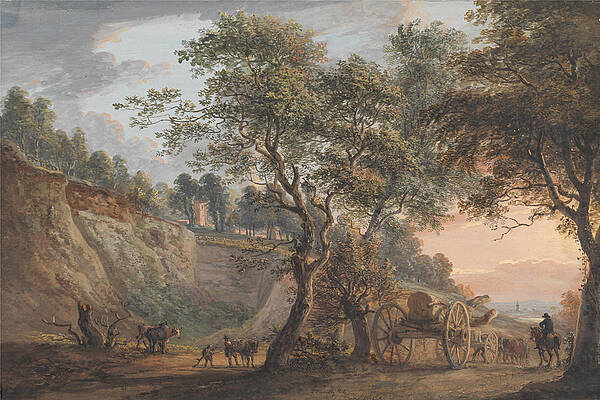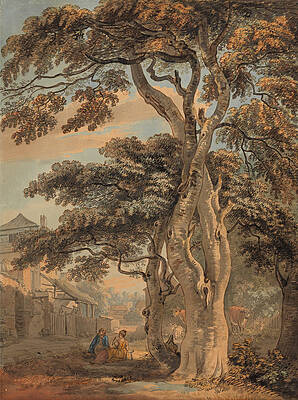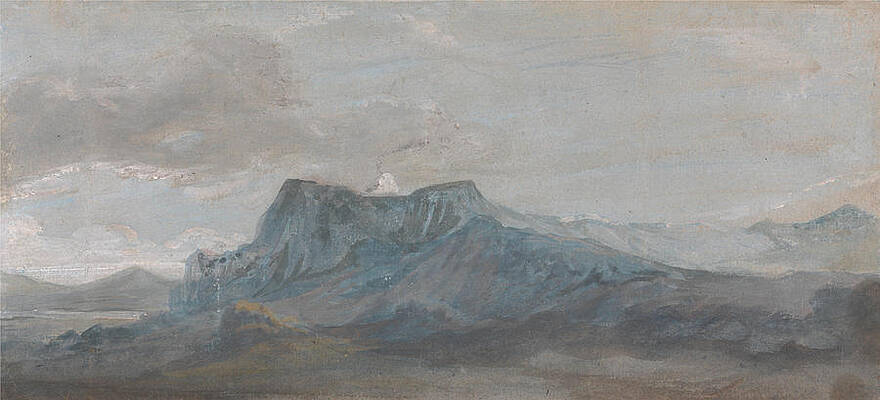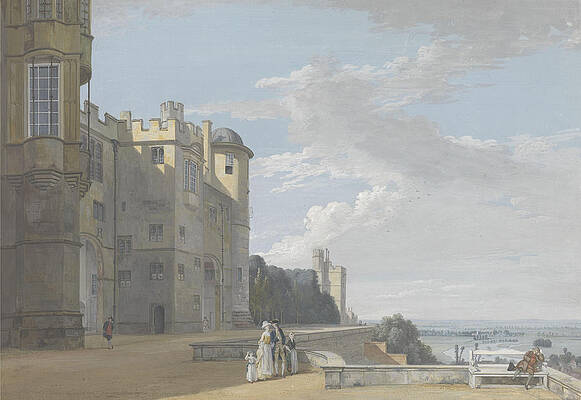Paul Sandby
Paintings
Roslin Castle
The Gunpowder Magazine, Hyde Park
View at Charlton, Kent
Hackwood Park, Hampshire
Couple in a Farmyard
Conway Castle
Dolbadarn Castle, Llanberis, North Wales
Welsh Mountain Study
An Old Market Woman Grinning and Gesturing with her Left Hand
Roslin Castle, Midlothian
The North Terrace, Windsor Castle, Looking West
Brook End, Essex
Approaching Rochester and the Medway
Ipswich from the Grounds of Christchurch Mansion
The Westgate, Canterbury
Bridgenorth, Shropshire
View in Wales
An Unfinished View of the West Gate. Canterbury
The Entrance to Chepstow Castle
Bothwell Castle from the South
Dartmouth Castle

Windsor Castle, view of the East Terrace
Paul Sandby RA (1731 – 9 November 1809) was an English map-maker turned landscape painter in watercolours, who, along with his older brother Thomas, became one of the founding members of the Royal Academy in 1768.[1]
Life and work
Paul Sandby by Sir William Beechey, 1789, National Portrait Gallery, London
Sandby was born in Nottingham, and baptised there in 1731, although his date of birth has traditionally been given as 1725.[2] In 1745 he moved to London[2] where he followed his brother Thomas in obtaining an appointment in the military drawing department at the Tower of London. Following the suppression of the Jacobite rebellion of 1745, Sandby was employed to assist in the military survey of the new road to Fort George, and of the northern and western parts of the Highlands, under the direction of Colonel David Watson. He was later appointed draughtsman to the survey.[3]
While undertaking this commission, which included preparing designs for new bridges and fortifications, he began producing watercolour landscapes documenting the changes in Scotland since the rebellion, and making sketches of Scottish events such as the hanging in Edinburgh of soldier-turned-forger John Young in 1751.[4]
He left his post with the survey in 1751, and spent some time living with his brother, who had been appointed Deputy Ranger of Windsor Great Park. There he assisted his brother, and made a series of drawings of the castle, the town, and its neighbourhood, which were purchased by Sir Joseph Banks.[3] His skills were applauded by fellow artists such as Thomas Gainsborough: if one wanted "real Views from Nature in this Country", declared Gainsborough in 1764, there was no better artist than Sandby, who frequently "employ'd his pencil that way."[4]
London Cries- A Muffin Man
He also etched a large number of plates after his own drawings, a hundred of which (including views of Edinburgh, which were published in a volume in 1765. In 1760 he issued twelve etchings of The Cries of London. He also made many plates after other artists, including his brother.[3] In 1753–4 he published, anonymously, several single caricatures satirising William Hogarth. He returned to the attack in 1762, and produced other satirical work sporadically throughout his career.[3]
It is not recorded how long Sandby lived with his brother at Windsor, but he is said to have spent part of each year in London, and much of his time was probably spent on sketching excursions. On 3 May 1757 he married Anne Stogden, and by 1760 he was settled in London.[3]
In 1760 he contributed to the first exhibition of the Society of Artists. He exhibited regularly with the society until the foundation of the Royal Academy eight years later, and was one of its first directors when it was incorporated in 1765. In 1768, he was appointed chief drawing master to the Royal Military Academy at Woolwich, a position he retained until 1799.[5] On the formation of the Royal Academy in the same year he was one of the 28 founder-members nominated by George III. He often served on its council, and contributed to all but eight of the exhibitions held between 1769 and 1809.[3]
Sandby made extensive journeys around Britain and Ireland, sketching scenery and ancient monuments.[3] He made his first recorded visit to Wales in 1770, later (1773) touring south Wales with Sir Joseph Banks, resulting in the 1775 publication of XII Views in South Wales and a further 12 views the following year,[4] part of a 48-plate series of aquatint engravings depicting Welsh scenery commissioned by Banks.
Trade card of Paul Sandby, drawing master
He died at his house in Paddington on 7 November 1809, and was buried in the burial ground of St George's, Hanover Square.[3] He was described in his obituaries as "the father of modern landscape painting in watercolors".[1]
Gallery
A Distant View of Maidstone, from Lower Bell Inn, Boxley Hill
A View of Vinters at Boxley, Kent, with Mr. Whatman's Turkey Paper Mills
Windsor Castle: View of the Round and Devils Towers from the Black Rock
Watercolour of Woolton Hall, Liverpool, c. 1781
Watercolor of the 1783 Great Meteor, 1783
Harlech Castle by Paul Sandby 1776
An Unfinished View of the West Gate, Canterbury
An Encampment in St. James Park
Bothwell Castle, from the South
Music by Moonlight
Landscape with beech trees and man driving cattle and sheep
Two Girls Carrying a Basket
Caricature of George Bubb Dodington and Sir Thomas Robinson
London Cries- A Girl with a Basket of Oranges
Italian Landscape with Castle, Cascade and Anglers
See also
English school of painting
References
Lambirth, Andrew (24 April 2010). "Arboreal glory". The Spectator. 312 (9478): 41.
"Paul Sandby (Biographical details)". British Museum. Retrieved 15 October 2014.
Monkhouse, William Cosmo (1885–1900). "Sandby, Paul". Dictionary of National Biography. London: Smith, Elder & Co.
Colley, Linda. Paul Sandby: Picturing Britain (The Guardian, 7 November 2009).
"British Museum collection: Royal Military Academy and Prince Rupert's Tower, Woolwich Academy - curator's note". Britishmuseum.org. Retrieved 2013-06-13.
Further reading
Monkhouse, William Cosmo (1897). "Sandby, Paul". In Lee, Sidney. Dictionary of National Biography. 50. London: Smith, Elder & Co. pp. 251–254.
Julian Faigan, Paul Sandby RA. The Collection in the City of Hamilton Art Gallery (University of Melbourne MA Thesis, 1984).
L. Herrmann. Paul and Thomas Sandby (Batsford, 1986).
Andrew Wilton & Anne Lyles. The Great Age of British Watercolours (1750–1880) (Prestel, 1993). ISBN 3-7913-1254-5
Anne Lyles & Robin Hamlyn. British watercolours from the Oppé Collection (Tate Gallery Publishing, 1997). ISBN 1-85437-240-8
Michael Charlesworth, Landscape and Vision (Ashgate, 2008), Chapter One.
Michael Charlesworth, "Thomas Sandby climbs the Hoober Stand", Art History, 19, 2, (1996)
External links
Paul Sandby online (artcyclopedia.com).
Picturing Britain: Paul Sandby (1731-1809) (Daily Telegraph - 27 July 2009).
Paul Sandby, Unlikely Founder of Dazzling School of European Art, Souren Melikian, New York Times, 16 April 2010
A detailed Paul Sandby biography Edited by Charles Holme. Text by Alexander J Finberg & E A Taylor. The Development of British Landscape Painting in Water-colours.
Connected Histories: British History Sources, 1500-1900 This JISC-funded web service provides federated searching of online historical resources for research. The web link provides access to primary sources which refer to Paul Sandby.
Profile on Royal Academy of Arts Collections
----
Fine Art Prints | Greeting Cards | Phone Cases | Lifestyle | Face Masks | Men's , Women' Apparel | Home Decor | jigsaw puzzles | Notebooks | Tapestries | ...
----
Artist
A - B - C - D - E - F - G - H - I - J - K - L - M -
N - O - P - Q - R - S - T - U - V - W - X - Y - Z
Retrieved from "http://en.wikipedia.org/"
All text is available under the terms of the GNU Free Documentation License

























